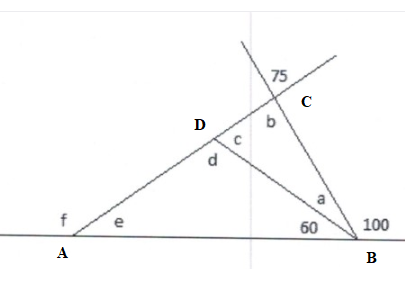Elementary Geometry For College Students, 7e
7th Edition
ISBN:9781337614085
Author:Alexander, Daniel C.; Koeberlein, Geralyn M.
Publisher:Alexander, Daniel C.; Koeberlein, Geralyn M.
ChapterP: Preliminary Concepts
SectionP.CT: Test
Problem 1CT
Related questions
Question
100%
Find the angle measurement of all the missing

Transcribed Image Text:**Problem 4**
The provided diagram features a combination of intersecting lines and labeled angles. Here's a detailed breakdown:
1. A horizontal line segment is shown where three angles adjacent to it are labeled:
- The angle on the left is labeled as \( f \).
- The central portion is divided into two angles, \( e \) and \( d \), created by a single intersecting line.
- The angles on the right side are labeled as 60° and 100°.
2. A set of intersecting lines bisects these angles at different points:
- Above the horizontal line, two intersecting angles are labeled:
- 75° on the left side of the intersection.
- \( b \) on the right side of the intersection.
- Between these two intersecting lines, the angles \( c \) and \( a \) are labeled below the intersection line.
**Key Angles Notations**
- **Angle of 75°**: Above the intersection line (slant to the left).
- **Angle \( b \)**: Above the intersection line (slant to the right).
- **Angle \( c \)**: Below the intersection, between the intersecting lines.
- **Angle \( d \)**: Adjacent to angle \( c \) below the horizontal line.
- **Angle \( a \)**: Directly below angle \( b \), adjacent to the angle labeled 60°.
- **Angle of 60°**: Positioned adjacent to angle \( a \) and below the horizontal line.
- **Angle of 100°**: Positioned adjacent to angle 60° to the very right, adjacent to the horizontal line.
These notations can be used to identify the sections of this geometric diagram for a more detailed analysis of the angles involved.
Expert Solution
Step 1
Consider the figure below.
First find angle b.
Then consider the triangle ABC and find angle e.


Step 2
Then consider the triangle ABD and find angle d using the sum property for triangles.

Step by step
Solved in 3 steps with 4 images

Knowledge Booster
Learn more about
Need a deep-dive on the concept behind this application? Look no further. Learn more about this topic, geometry and related others by exploring similar questions and additional content below.Recommended textbooks for you

Elementary Geometry For College Students, 7e
Geometry
ISBN:
9781337614085
Author:
Alexander, Daniel C.; Koeberlein, Geralyn M.
Publisher:
Cengage,

Elementary Geometry for College Students
Geometry
ISBN:
9781285195698
Author:
Daniel C. Alexander, Geralyn M. Koeberlein
Publisher:
Cengage Learning

Elementary Geometry For College Students, 7e
Geometry
ISBN:
9781337614085
Author:
Alexander, Daniel C.; Koeberlein, Geralyn M.
Publisher:
Cengage,

Elementary Geometry for College Students
Geometry
ISBN:
9781285195698
Author:
Daniel C. Alexander, Geralyn M. Koeberlein
Publisher:
Cengage Learning